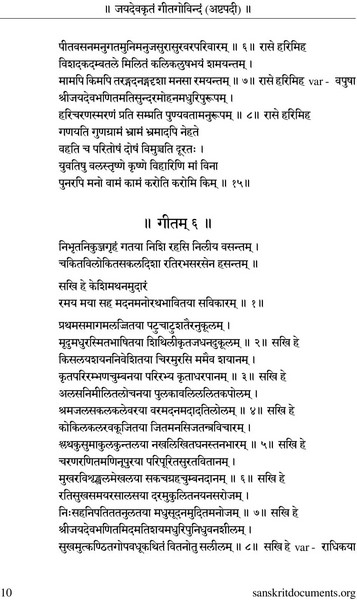SRI KAMAKOTI PRADIPAM
Volume: 21 Roudra year- Chitra, Vaikasi April, May- 1980
Vol No. 3, 4
The Ashtapadi is a work by Jayadeva, a great devotee of Krishna. It is replete with elements conducive to bhakti rasa—music and dance. It was composed by Jayadeva at the Jagannatha Kshetra of Puri, while his wife, Padmavati, danced to its music. Both music and dance are among the sixty-four kinds of offerings made to god at the time of pooja or worship. Each of these offerings helps us to invoke the Lord’s karuna or compassion on us. Of these, music and dance have very intense, personal significance. The Lord is of the form of music. The art of dance is a mingling of music with the ambient air.
The Supreme Being, the Paramatma, is of the form of music. Parashakti, the Supreme Energy, is of the form of air which is favourable to convey sound or music. It is this concept that appeared embodied in the form of Radhakrishna and performed several lilas in order to lead the hearts of devotees into maturity. In general, Lilas enchant every one. However, the deep esoteric significance of these lilas is enjoyed only by the most enlightened of devotees. It is such a devotee who is a parama-ekanti (the highest among the enlightened), a jeevan mukta (the liberated). Vedavyasa was one such bhakta. He gave the world deep, precious philosophical thoughts, through the eighteen puranas.
Ashtapadi Lyrics Tamil Pdf
In the tenth purana, the Brahmavaivarta Purana, Vyasa narrates the story of Sri Radhakrishna. The Garga Samhita, which serves as an exposition to the Purana, also deals with this story in great detail, using an engaging manner to bring out the story’s philosophical significance. The Ashtapadi was composed with these two texts as its source.
Sri Krishna is with his wife Viraja in Goloka. When Radha, on hearing about this, comes there in anger, Krishna turns Viraja into a river and hides himself. Radha returns to her abode disappointed only to be met by Krishna, who pretends to be in search of her calling out her name, “Radhe…Radhe.” When Radha turns her face away in anger, Krishna tries to pacify her. However, she would not be appeased. Even when Krishna entreats her saying, “Do not be angry, O Radha! I plead with you. I shall not be attracted to any other woman henceforth,” she does not relent.
The great devotee Sudhama is offended by Radha’s behaviour. Krishna, then, goes back to his love sport with Viraja. Radha, who could not bear to be separated from Krishna, sends her apologies to Krishna through a friend. Krishna replies to the message saying that he has no strength even to walk, because of the intense suffering caused by Radha’s separation and asks Radha to come to him. On receiving this message, Radha sets out to meet Krishna.
However, Sudhama, who is still angry with Radha, bars her entry into the place. Radha curses him to become an asura and he, in turn, curses her that she would be separated from Bhagavan Krishna. At this point, the Lord Himself comes out and effects a reconciliation between them. Sudhama is to be born as Shankachuda, would be killed by Shiva and would return to Goloka. Radha would be born as the daughter of Vrishabanu. Travis scott discography torrent. The Lord assures her that he would be born as the son of Vasudeva, would grow up in Nanda’s household and would marry her. They were to live on earth for a while and then return to Goloka. This is the story sung by Jayadeva in the 24 verses of the Ashtapadi.

The events that happen in Goloka, as well as those that happen on earth are narrated in Jayadeva’s work. The Gayathri Mantra, the Mantra Raja, the mother of all Vedas, has 24 syllables. Based on the ratio of a thousand verses for each of the 24 letters, Valmiki composed the Ramayana in 24,000 verses. On a similar scale, Sri Thyagaraja Swamigal composed 24,000 keerthanas. Jayadeva, on the same basis, composed 24 Ashtapadis.
Since it is a song (gita) about Govinda, it is called the Gitagovinda. Since it is composed in eight padas (in keeping with rhythms of dance), it is also called the Ashtapadi. Several slokas are added to the songs in the beginning and in the end. Many writers have specified the raga and tala in which these verses are set. Yet others sing these as taught by their gurus.
Since it is considered a Kavya, a work of poetry, it is divided into sargas or chapters, like other kavyas such as the Raghuvamsha. This work has been composed in twelve sargas, bearing the Dvadashakshari mantra (twelve-syllable mantra) of Krishna. The names given by Jayadeva to each of these sargas are also unique and meaningful. They bestow grace upon devotees.
